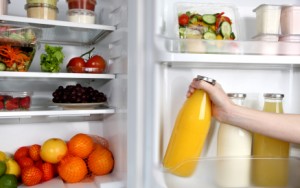SIX STEPS To An Organized Refrigerator
 You’ve been an absolute whirlwind, an organizing maniac, and your closets are getting whipped into shape like never before. Good for you! Life is so much easier when we’re organized. But, there is another “closet” in your house that’s not getting the same focus. Your “cold closet”… better known as your refrigerator.
You’ve been an absolute whirlwind, an organizing maniac, and your closets are getting whipped into shape like never before. Good for you! Life is so much easier when we’re organized. But, there is another “closet” in your house that’s not getting the same focus. Your “cold closet”… better known as your refrigerator.
Look at your refrigerator like a closet. It has drawers, storage bins, specialized storage spaces, and even a light. Your refrigerator already has everything that an organized closet should have. The drawback to any closet is the “dead” space. You know, the area in your closet that you can’t reach, or that things get pushed back to, never to be found again. The problem that is exclusive to your “cold closet” is that, unlike your clothes closet, when items get pushed into the “dead zone” and forgotten, they either freeze or spoil. How many frozen bags of lettuce and molding jars of diced tomatoes have you thrown away in the last year? Way too many, I’m sure. So, let’s get your refrigerator organized! Viewing your refrigerator as another closet, take these six simple steps and get your refrigerator working for you, not against you.
Step 1: Remove The Contents Of Your Refrigerator And Place In Cardboard Boxes
Collect some small to medium size cardboard boxes with top flaps still attached. Your friendly, neighborhood liquor store usually has empty boxes sitting around to give away for the asking. These boxes are heavy duty and small enough to handle. Now, sit down in front of your refrigerator and take the delicate perishables like fruit, vegetables, meat, eggs, and cheese out and carefully fill your boxes. Put your larger items like gallons of milk or juice in a separate box. Put your smaller items, jars, and cans in a box. Put your containers of leftovers, cartons of cottage cheese, yogurt, etc. in a box. Keep a trash bag nearby and throw out, hopefully for the last time, anything that looks suspicious. If you don’t remember it, or it has definite signs of age or frost, don’t keep it any longer. Cover the boxes up with the flaps and slide them into a corner. Drape a blanket over the top of your pile to keep the food cold while you clean up.
Step 2: Wash The Refrigerator Thoroughly
If you’ve only been wiping up spills in your refrigerator as needed, now is the time for a full-out cleaning. I prefer mixing a half and half ratio of white vinegar and hot water. It’s safe, inexpensive, and it works. Some people prefer mixing a solution of baking soda and water which is an excellent cleaning solution, as well. What you don’t want to use is a strong smelling, heavy-duty industrial style cleaner. Your cleaning solution must be food-friendly. Start by turning your refrigerator temperature control off, since you’ll be working with the door open and you don’t want it to keep running. Remove the drawers and all the racks that you can, and place them in a sink or tub with dish soap and hot water to soak. Now, starting at the top, use a clean, absorbent cloth to wipe down the entire inside of your refrigerator, top, sides, bottom, and door shelves, rinsing out your cloth and changing water when you need to. Don’t forget the drip-pan underneath your refrigerator. Remove the grill in front of your drip-pan, wipe off the grill, pull out the pan and wash it as needed. If it’s been collecting dirt for some time now, you may want to add it to your soaking items. You’ll also want to wipe up underneath your refrigerator now, since the drip-pan has been removed and you can get at the floor. Scrub up your drawers and racks, rinse them well, and wipe each one down with a fresh vinegar and water mixture to remove any soap residue, and reinstall them in your refrigerator. Don’t forget to put your drip-pan and front grill back, then turn your refrigerator temperature back where it was and shut the door.
Step 3: You Have Time For A Break
Scrubbing out the interior of your refrigerator takes some effort. Some would say it’s back breaking work. No matter how your muscles and bones react to this physical effort, whether you feel pretty sore or it wasn’t so bad, you deserve a ten minute break. And this is the time for a short break, since your refrigerator needs to come back down to the temperature you set. Your cold food will stay cold in the cardboard boxes for a few more minutes, so pour yourself some coffee, tea, a soft drink, or water, and put your feet up. Okay? Feel better? Great! Back to work!
Step 4: A Whole New View Of The Interior Of Your “Cold Closet”
Open your refrigerator and take stock of the interior layout just like you would with any other closet. Assigning specific spots for the food items you store most often will stop the constant shuffling around, and eventually discarding, containers of food. For instance, if you keep a couple gallons of milk on hand at all times, make a spot for them now. If you normally have a dozen or more eggs in your refrigerator, a narrow spot between a top drawer and a shelf might be just right. If you have an egg keeper in your door, it’s really okay to use it for eggs as long as you are not storing them outside their carton for long periods of time. Just like the other closets in your house, it’s all about “a place for everything and everything in its place”, using storage pieces specifically designed for certain items, and storing like-items together in bins. This is where it gets tricky… your “cold closet” has areas that may not be suited for all storage. If food freezes when it gets shoved to the back of your refrigerator, look for small plastic bins that fit in those Arctic areas to gather less fragile items together, saving the room in front for your more delicate food items. Now that you have gathered some little storage items together and assessed your needs, you are ready to organize your refrigerator.
Step 5: Putting Your Refrigerator Back Together
Drag your cardboard boxes back over to the refrigerator. Open the boxes of the delicate items like fruits, vegetables, meats, eggs, and cheese and immediately place them in the drawers or areas where they are intended to be stored. Close the drawers tightly and continue. Grab the large items like milk and juice and place them in the spots that you’ve designated for their permanent home. If you store bread or other large items, put those in their spot. Now, you should be left with your smaller items. Close the refrigerator and have a seat next to your boxes of food and small plastic storage bins. Start sorting your smaller food items according to use and placement. For instance, if you have a collection of hot sauces or other condiments that you don’t use that often, place them together in a small plastic bin that you can push to the back recesses of your refrigerator. Continue putting less fragile and seldom used items together and placing them in either small plastic bins or directly in the back corners of your refrigerator, wiping each container with a damp cloth as you go. Gather those little leftover packets of seasonings together in a small food storage container and slip it in your door shelf. Place your salad dressing bottles in the door shelves, along with any other larger jars or cans. Now, you should have open space in front of all those little bins which were filled and pushed to the back. Your cottage cheese, yogurt, sour cream, and all those leftovers stored in zip lock bags and containers now have a place to go where they will not freeze or get lost!
Step 6: Train Your Family
Now that everything is safely tucked away in your refrigerator, with a space designated for everyday items, you need to train your family to put the milk, eggs, etc. back where they found it. Simple concept, but if not followed, it can turn the best organized homes upside-down again. Bring your entire family on board and you will have better success.
Now that your “cold closet” looks and operates like the rest of the organized closets in your home, you should no longer be surprised by those fuzzy containers of who-knows-what that used to lurk way in the back of your refrigerator. With everyone’s cooperation, your newly organized home will remain neat and orderly, even the busiest closet in the house… your refrigerator.








January 2nd, 2009 9:00 am
I organize my refrigerator by keeping the top shelf solely for dairy products like yoghurt, butter, milk.A separate shelf for food items such as left overs and another shelf for jars and processed foods
January 6th, 2009 12:01 am
Aarthi’s idea for organizing by category of food is awesome! It just goes to show you, different people think differently. I know someone who organizes her cupboards alphabetically… so, there you have it. Thanks for reading!
January 12th, 2009 8:25 pm
I just cant organize my fridge… Men just dont have time, nor the motivation to do this…
January 14th, 2009 4:14 pm
As all organizing professionals will tell you, the busier you are, the more important it is to be organized. The reason? If you spend 5 minutes every day looking for something in a closet or refrigerator, that’s 5 minutes wasted. By taking the time initially to get organized you save time in the long run. The motivation to get and stay organized is to save time and money. We’re all too busy to spend time on a project like organizing our homes… but I’m far too busy to be rummaging around my refrigerator trying to find the mustard and far too frugal to be throwing out forgotten food.
April 5th, 2009 11:50 am
thanks neatfreak 🙂 glad you liked my way of organising the fridge. i guess men have excuses for not doing stuff. I agree with you – if you don’t have time, there’s all the more reason to be organised. Which is why women spend a lot of time organising their stuff. They’re multi-tasking all the time!